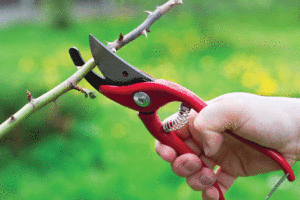March is the month of preparation.
Take the time to prepare your garden for the growing season by checking soil pH and cleaning up winter debris. 
March is the best time for pruning trees and shrubs, especially for fruit and shade trees.
If you have fruiting or flowering trees, bring in a few pruned branches and place in water with flower preservative, and watch spring to begin to bloom inside as well.
Week One
• Deadhead fall pansies to encourage reblooming as the weather warms up.
Apply Espoma’s Flower-tone at the suggested rate to encourage larger blooms.
• Check pH of the garden soil for annuals and perennials, which should be at 6.0 to 7.0.
Also, applications of organic matter, such as Leafgro or composted manure, worked into the soil are most helpful.
Week Two
• Prepare larger houseplants too big to be repotted for the coming season of growth by top-dressing the soil, replace the missing soil with a 50-50 blend of Leafgro and potting soil.
Be sure to also add the recommended dose of slow-release fertilizer around the edge of the pot.
• Rhododendrons are evergreen shrubs that require proper feeding and pH.
These plants require a pH of 4.0 to 5.5. Be sure to test at the dripline of the shrub, apply a sulfur amendment to lower pH.
Rhododendrons are light feeders, so do not apply commercial fertilizers.
We suggest that you use Holly-tone or Cottonseed meal by Espoma.
Week Three
• Young emerging daylilies are very desirable to deer.
If deer have been a problem, spray the tender young shoots with Liquid Fence.
One application should be enough until the foliage toughens up.
• Fruit tree pruning should be done now.
Be sure to rake up all the pruned branches, fallen leaves, and unused fruit and debris from under and around the trees.
Discard or burn all the debris and do not compost.
A little extra work now could save you hours of work later on in the season.
Week Four
• Replace or sharpen the blades on your lawn mower as part of your spring servicing.
Dull blades will pull and tear the grass, resulting in an unsightly lawn.
• This week is perfect timing for applying a pre-emergent to stop crabgrass from sprouting.
We suggest several products to do this job, and there are two ways to do this.
Jonathan Green has a spring lawn fertilizer with the chemical dimension to prevent and even kill sprouted crab grass.
This product will work for 16 weeks after which time you need to re-apply another crabgrass preventative.
Espoma has an organic product made from corn called Corn Gluten, which also prevents crabgrass from sprouting.
This product also provides a small amount of nitrogen to jump start your lawn.
Bonide also has a spray product which will also work.
* * *
March is for pruning.
Prune newly planted trees lightly the first few years to control the development of the scaffold or limb structure.
Do this by only removing branches heading into the center of the tree or crossing others.
Never take away more than 20-25 percent of a tree’s growth as this could cause “water sprouts.”
Always prune out any winter or storm damage.
Prune out any low angle limbs growing between noon and 1:30 p.m., or between 10:30 a.m., and noon.
These low angle branches are structurally weak and will eventually break under the weight of its own leaves, fruit or snow.
Thin and immature branches growing at poor angles should also be pruned out.
High angle limbs are a problem and should also be pruned since they are prime candidates for weight load injury.
Flowering trees and shrubs that bloom on new wood should be pruned before growth begins in late winter or early spring.
Flowering trees and shrubs that bloom on old wood should be pruned immediately after they bloom to avoid cutting off branches where its buds are being initiated for the following season.
To control height, prune after new growth has fully developed in both trees and shrubs.
To slow or dwarf growth, prune after the season’s new growth is complete.
To regenerate an overgrown multi-stemmed deciduous shrub just before it begins its spring growth take out a third or a quarter of the branches.
When pruning roses, place the cuts so the center of the bush remains open for maximum air circulation.
Remove dead canes, growth thinner than a pencil, and canes crossing the center that are growing in the wrong direction or crowding out other canes.
Carpet roses should be pruned back to about 6 inches tall.
Forsythia need to be pruned right after spring flowering pruning one third of the branches back by one-third.
(Editor’s Note: Ken Morgan is owner of Robin’s Nest Floral and Garden Center in Easton, Md.)



